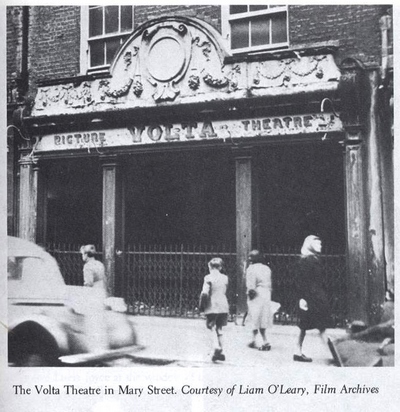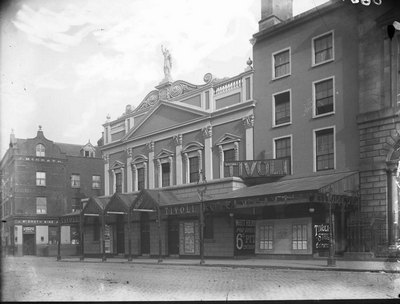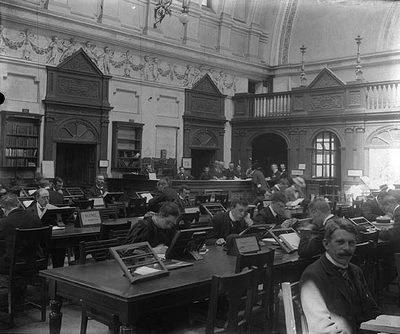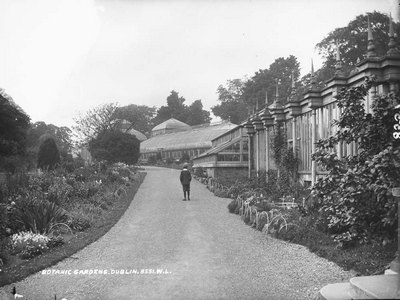Social Life
View the photo galleryIn 1911 Dublin Castle was the focus of government social life with its traditional mixture of pomp and pageantry. The Castle’s balls and lavish dinners were the ultimate expression of high society at play. The banquet halls filled with guests dressed in finely-ornamented clothes and splendid uniforms, waited on by staff attired in state livery. It was a scene very much in keeping with those played out in second cities all over the British empire.
Around the corner from the Castle, but representing a different world, were the pubs of Dublin. These were the single most notable feature of the city’s social life, a vibrant institution for all classes and in all areas (see Lower George’s St., Kingstown). As an institution, the pub was the preserve of men, with women generally excluded. As early as 1610 a writer remarked that “in Dublin the whole profit of the towne stands upon alehouses … there are whole streets of taverns.” Workingmen’s pubs, tough, raw establishments, were everywhere in the city, at once providing an escape from poverty and increasing it.
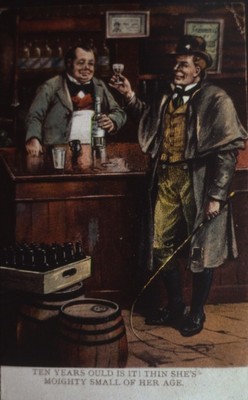
Pubs were an integral part of Dublin social life. This cartoon take on pub humour dates from 1918
(DCLA, Dixon Slide 40.27)
In 1911 Dublin’s pubs, many of them owned by country people, were thriving despite the condemnations of temperance reformers (including Matt Talbot, who lived in Rutland St.) and were the focal point of popular culture in the city. Temperance reformers sought to establish recreational facilities (see rerefence to 43 Clarendon St.) of their own, and they succeeded, but never to the point of threatening to displace the public house in importance.
As if to confirm this, alcohol was a frequent theme in Irish literature. Stephen Dedalus remarks in Ulysses how it would present a formidable challenge to cross Dublin without going past a single public house. One of the pubs which James Joyce himself was unable to pass was Davy Byrne’s pub on Duke Street, which was mentioned in both Dubliners and Ulysses. In 1911 Davy Byrne was into his third of five decades as proprietor, while on nearby South Anne Street, John Kehoe was also running a pub of great repute. Both pubs still exist today.
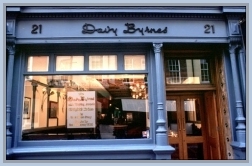
Davy Byrne's pub, South Anne St., as it is today
(from http://www.dublinpubs.ie/)
Public houses were at the heart of the revival of traditional music in the city. Among the many native musicians was the piper prodigy, Leo Rowsome, aged 8, of Armstrong St., Rathmines. Eamonn Ceannt, who lived at Herberton Lane, Kilmainham, later a leader in the 1916 Rising, was also a prominent piper. Dublin was the home of a range of music publishers, like Partridge of Vernon Parade, Clontarf, and Pigott and Company, while there were regular concerts given at the Antient Concert Rooms and operatic performances at theatres on Burgh Quay and Hawkins Street.
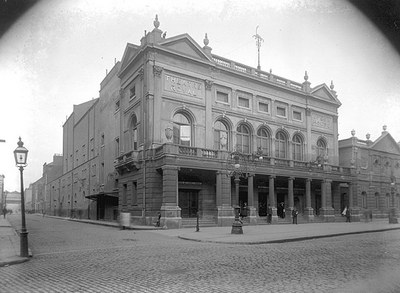
The Theatre Royal on Hawkins Street, pictured here c. 1910-30, was a famous venue for pantomine
(NLI, EAS 1700)
At various points across the city were concert halls, like this one at 44 Clarendon St., and band rooms, like this on on Thorncastle St. The number of people who created careers from music through these years is astonishing. There were music teachers, like Twelvetrees on Anglesea Road, organ builders, like De Mont at Lennox St., piano tuners, like William Loredor at Gloucester St. , orchestral musicians, like McKeon on Church St., and a small army of professional musicians, like Carver on Oxmantown Road.
Music defied class, but the city’s clubs were clear in their divides. In parts of the city there were workingmen’s clubs, just as there were across the towns and cities of Britain (see reference to club at 187 Emmet Road, Kilmainham). Equally, the fashionable clubs of London were replicated in Dublin. There were clubs on Stephen’s Green and on Clare Street, but the most prestigious was the Kildare Street Club, which, on the night that the 1911 census was taken, had 32 servants under the direction of the Club Steward, all to look after six visitors. Amongst the six visitors were a land owner, a land agent, a retired colonel, the official starter at Irish race meetings and Lord Fermoy.
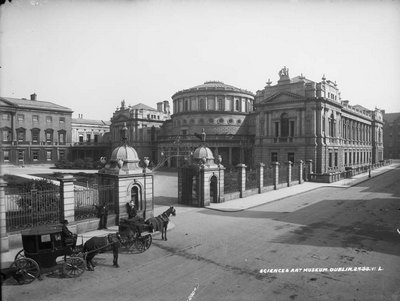
Kildare Street was home to not only to the National Museum, seen here c. 1900, but also to the fashionable Kildare Street Club. On census night 1911, the club had 32 servants catering for 6 visitors
(NLI, LROY 2536)
Around the clubs grew up a necklace of establishments, including Prost’s hairdresser and perfumer on Stephen’s Green and a Turkish baths at Leinster St. . It was to the people who frequented the clubs that the city’s antiques and fine arts dealers, like Persse’s on Kildare St., and Young’s at South Anne St., looked for business. Dublin was home to artists like Dora Philips on Drumcondra Road, landscape painters like Joseph Kavanagh of Lower Abbey St. , illuminators like Edward Dolan at Elizabeth St. , designers like Robina McConnell at Lower Sackville St. , and picture framers like Richard Persse at Clarendon St. .
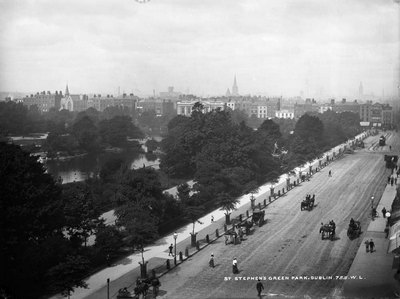
St. Stephen's Green, viewed here c. 1900, was home to numerous social clubs for the fashionable elite
(NLI, LROY 755)
Several of the artists working in Dublin had come over from England and so had a range of other entertainers. In 1911 the circus was in its heyday (see return for Bernard Carroll, circus agent, at Millmount Place). British and continental circuses regularly visited Dublin and there were a number of local circuses, including Duffy’s and Fossett’s, which was then known as Powell and Clarke’s circus and was run by a ventriloquist, Frank Lowe.
Cinema arrived in Dublin in April 1896 when a demonstration was held in Dan Lowery’s Star of Erin theatre (later the Olympia). James Joyce was briefly the manager of the first cinema in the country, the Volta Electric Theatre, which opened in December 1909, and where Joseph Simpson of Manor St. was now the Assistant Manager . This sparked the establishment of several other institutions which showed motion pictures (see return for Andrew Bennett of Lower Abbey St., cinematograph operator) . The first film made in Ireland was, fittingly, a tale of emigration made in 1910, called The Lad from Old Ireland.
Comedy, pantomime and a talent for the absurd were hugely popular. The comedy was often of the music-hall variety (see return for Arthur Coma, music-hall artist, Holles St.), a robust performance of bawdy sketches (see return for Alice Logan, music-hall actress, Eden Quay) and other material by troupes who often engaged with the audience. Many performers came to Ireland from England, bringing their music hall acts (see boarders in Bennett household, Lower Abbey St. ). The most famous venue for pantomime in the city was the Theatre Royal, but it was in one of its main competitors, the Queen’s Royal Theatre that that the acclaimed Jack Judge sang the song ‘Tipperary’ for the first time in a production of Mother Goose.
Beyond popular culture there was a range of institutions which catered for educational recreation. In 1911 the National Gallery was expanding under the direction of Walter Armstrong, and continued to do so under his successor, Hugh Lane. The National Museum’s collection (see return for museum porter Frederick Kennedy of Church Lane) had been expanded through amalgamation with the Natural History Museum, and by the addition of collections from the Royal Dublin Society (see return for RDS Assistant Registrar, Moran of Park Avenue) and the Royal Irish Academy.
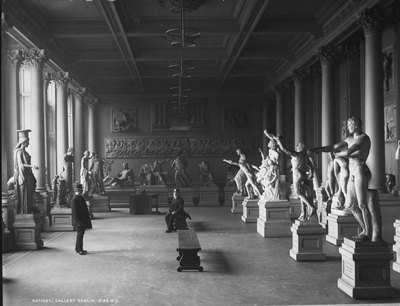
The interior of the National Gallery. In 1911 the Gallery was expanding under the direction of Walter Armstrong
(NLI, LIMP 3135)
The Public Libraries Act of 1902 facilitated the development of smaller libraries (see return for librarian Byrne of Priesthouse) like the Carnegie Free Library at Newtown Avenue in Blackrock, across the city, while the National Library on Kildare Street and Marsh’s Library in St. Patrick’s Close were also important institutions.
For those who preferred their relaxation outdoors, Dublin was served by a range of impressive parks, including the People’s Park in Blackrock (see return for Butler, park keeper, of Rock Road). Pride of place was held by the Phoenix Park (see return for Doyle, park caretaker), stocked with deer and pheasants, and dotted with impressive houses and monuments, not least the Vice-Regal lodge and the Wellington monument. The park had a range of different gardens, bandstands and playing fields, and had a fine zoo, which had been open since 1831 (see return for Brodie, gardener).
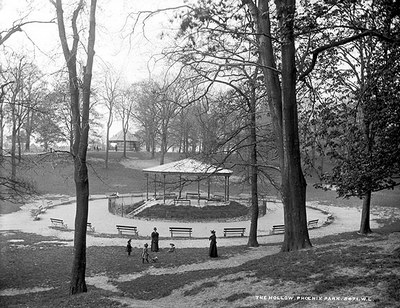
Pride of place among Dublin's impressive range of parks was the Phoenix Park, pictured here c. 1900
(NLI, LROY 5471)
The Botanic Gardens in Glasnevin (see return for John William Besant, Head Gardener) were renowned as a centre of horticultural excellence, filled with thousands of flowers, plants and trees. In 1911 its curator Frederick Moore, who served in the position for 42 years, was knighted for work which had seen his gardens gain a reputation equal to those of Kew in London. Also, in 1911, Herbert Park was opened in Ballsbridge. Previously the site of the Irish International Exhibition in 1907, the land had been donated to the public by the Earl of Pembroke.


